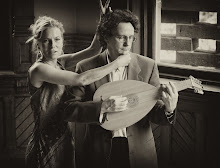Here's the revised program for the New Year's Day concerts.
Sonata a Tre, Op 1, No. 9 in G Major Arcangelo Corelli (1653-1713)
Sonata in C maj. for violin & continuo Antonio Vivaldi (1678-1741)
Fantasia No. 10 in D Maj. Georg Philipp Telemann (1681-1767)
Sonata Prima a Doi Violini Biagio Marini (c1597-1665)
Intermission
Ceccona Giovanni Zamboni (fl. early 18th c.)
Sonata Pisendel
Gulliver Suite Telemann
Intrada-Lilliputsche Chacconne- Brobdingnagische Gigue-Reverie der Laputier, nebst ihren Aufweckern-Loure der gesitten Houyhnhnms & Furie der unartigen Yahoos
Sonata a Tre, Op 1, No. 10 in G minor Corelli
We begin and end our concert with some of the most influential music of the period. It is impossible for us to overstate the popularity of Corelli’s trio sonatas, so we should leave it to Roger North, writing in the early 18th century, to tell us what the sonatas did, at least, to English musical culture. They ‘cleared the ground of all other sorts of musick whatsoever’ and ‘are to the musitians like the bread of life’ and contributed, with opera, to the ‘circumstances which concurred to convert the English Musick intirely over from the French to the Italian taste’. Corelli’s Opus 1 and 3 sonatas are scored for two violins, organ continuo with ‘violone or arciliuto’ as the melodic bass instrument.
As well as this suite on Swift’s Gulliver’s Travels Telemann wrote other ‘programmatic’ including orchestral suites depicting life on the river that runs through Hamburg, the battles of the Frankfurt stock exchange and the tales from Cervantes’ Don Quixote. We print the scores of two of the movements which show the tiny note values he uses for the Lilliputians (they are 256th notes, or, we think, demisemihemidemisemiquavers) and the huge time signature and note values he uses for the giant Brobdingnagians (their jig is in 24-1). Telemann’s unaccompanied violin Fantasias are far less famous than Bach’s solo violin works.
Vivaldi needs little introduction to concert goers. The sonata we present here comes from a manuscript which was owned by Charles Jennens, who wrote the libretto for Handel’s Messiah. Thus it also demonstrates how Italian music dominated England in the 18th century. Vivaldi wrote many sonatas for the violin virtuoso Johann Pisendel who worked at court in Dresden. It seems very possible these pieces have already been played on the same program.
Muffat was a much travelled musician who on his travels had met the masters of the Italian and French styles – Lully and Corelli. He wrote a manual for a German readership which discusses the difference between the styles, contemporary violin techniques (which you hear put into practice on this concert) instrumentation and many other topics of interest to we who are aiming for historically informed performance.
Printed in Lucca in 1718, the Sonate d’intavolatura di leuto Zamboni, a Roman who was lutenist at Pisa Cathedral, represents the swansong of Italian solo lute music, though the instrument continued to be used as a continuo instrument and as an obbligato instrument in operas and oratorios till the end of the baroque.







































